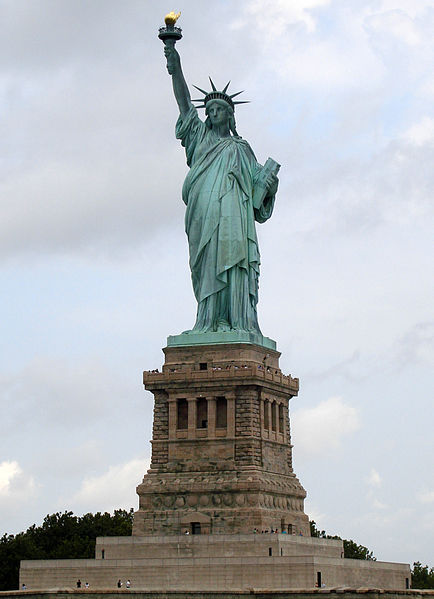|
Learn the U.S. Constitution
|
|
|
|
| Follow @LearnTheConst |
The Statue of Liberty
Originally named, "Liberty Enlightening the World", and standing more than 300 feet high, the Statue of Liberty, located in New York Harbor was a gift of international friendship from the people of France to the people of the United States. The statue is constructed of copper sheets which are assembled on a framework of steel supports. An inspiration to millions of immigrants, this statue is a universal symbol of freedom, democracy, and diplomacy. The relationship between the United States and France began during America's quest for independence from Great Britain in 1776. Benjamin Franklin was among those who served on the diplomatic front during the Revolutionary War. By living in Paris as the American ambassador, Benjamin cultivated a relationship with the French government and the French people. As a result, French soldiers fought alongside the American colonists. Paris was the site for peace negotiations between the United States and Great Britain at the end of the war. In 1865, Edourd de Laboulaye of France developed the idea of creating a giant statue to honor the friendship and the commitment to liberty between France and the United States. He formed the French-American Union to raise money for this project. The Statue was a joint effort between America and France and it was agreed upon that the American people were to build the pedestal, and the French people were responsible for the Statue and its assembly here in the United States. However, lack of funds was a problem on both sides of the Atlantic Ocean. In France, public fees, various forms of entertainment, and a lottery were among the methods used to raise funds. In the United States, benefit theatrical events, art exhibitions, auctions and prize fights assisted in providing needed funds. French sculptor Frederic Auguste Bartholdi was commissioned to design a sculpture with the year 1876 in mind for completion, to commemorate the centennial of the American Declaration of Independence. Bartholdi required the assistance of an engineer to address structural issues associated with designing such a colossal copper sculpture. Alexandre Gustave Eiffel (designer of the Eiffel Tower) was commissioned to design the massive iron pylon and secondary skeletal framework which allows the Statue's copper skin to move independently yet stand upright Back in America, fund raising for the pedestal was going particularly slowly, so Joseph Pulitzer (noted for the Pulitzer Prize) opened up the editorial pages of his newspaper, "The World" to support the fund raising effort. Pulitzer used his newspaper to criticize both the rich who had failed to finance the pedestal construction and the middle class who were content to rely upon the wealthy to provide the funds. Pulitzer's campaign of harsh criticism was successful in motivating the people of America to donate. "Financing for the pedestal was completed in August 1885, and pedestal construction was finished in April of 1886. The Statue was completed in France in July, 1884 and arrived in New York Harbor in June of 1885 on board the French frigate "Isere" which transported the Statue of Liberty from France to the United States. In transit, the Statue was reduced to 350 individual pieces and packed in 214 crates. The Statue was re-assembled on her new pedestal in four months time. She was a centennial gift ten years late. President Grover Cleveland dedicated the Statue of Liberty before thousands of spectators, on October 28, 1886. Since the 1892 opening of nearby Ellis Island Immigration Station, Lady Liberty has welcomed more than 12,000,000 immigrants to America. Give me your tired, your poor, These are the famous lines from Emma Lazarus, which are engraved on the statue's pedestal. Details "Visitors climb 354 steps to reach the crown or 192 steps in order to reach the top of the pedestal. There are 25 windows in the crown which symbolize 25 gemstones found on the earth. The seven rays of the Statue's crown represent the seven seas and continents of the world. The tablet which the Statue holds in her left hand reads (in Roman numerals)"July 4th, 1776." The total weight of copper in the Statue is 62,000 pounds (31 tons) and the total weight of steel in the Statue is 250,000 pounds (125 tons.) Total weight of the Statue's concrete foundation is 54 million pounds (27,000 tons). The copper sheeting of the Statue is 3/32 of an inch thick or 2.37mm. "Wind sway: winds of 50 miles per hour cause the Statue to sway 3 inches (7.62cm) and the torch sways 5 inches (12.70cm) and the torch sways 5 inches (12.70cm)."
|
|
|
|
|
|
|
There have been many tributes to the Constitution but the highest tribute of all is the willingness of a person to take the time to study it. The Constitution is an exciting charter for human freedom that establishes nearly 300 vested rights as they apply to various segments of the American society. Many people do not know the nature of these rights or how too protect them. This is why many of those rights have been eroded or lost. For more information visit our blog. |

|
|
